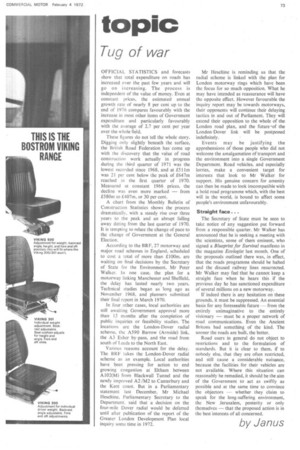topic
Page 77

If you've noticed an error in this article please click here to report it so we can fix it.
Tug of war
OFFICIAL STATISTICS and forecasts show that total expenditure on roads has increased over the past few years and will go on increasing. The process is independent of the value of money. Even at constant prices, the estimated annual growth rate of nearly 8 per cent up to the end of 1976 compares favourably with the increase in most other items of Government expenditure and particularly favourably with the average of 2.7 per cent per year over the whole field.
These figures do not tell the whole story. Digging only slightly beneath the surface, the British Road Federation has come up with the discovery that the value of road construction work actually in progress during the third quarter of 1971 was the lowest recorded since 1968, and at £511m was 21 per cent below the peak of £647m reached in the first quarter of 1970. Measured at constant 1966, prices, the decline was even more marked — from £580m to £407m, or 30 per cent.
A chart from the Monthly Bulletin of Construction Statistics shows the process dramatically, with a steady rise over three years to the peak and an abrupt falling away dating from the last quarter of 1970. It is tempting to relate the change of pace to the change of Government at the General Election.
According to the BRF, 27 motorway and major road schemes in England, scheduled to cost a total of more than £100m, are waiting on final decisions by the Secretary of State for the Environment, Mr Peter Walker. In one case, the plan for a motorway linking Manchester and Sheffield, the delay has lasted nearly two. years. Technical studies began as long ago as November 1968, and planners submitted their final report in March 1970.
In four other cases, local authorities are still awaiting Government approval more than 13 months after the completion of public inquiries or feasibility studies. The locations arc the London-Dover radial scheme, the A590 Barrow (Arnside) link, the A3 Esher by-pass, and the road from south of Leeds to the North East.
Various reasons account for the delay. The BRF takes the London-Dover radial scheme as an example. Local authorities have been pressing for action to end growing congestion at Eltham between A102(M) from Blackwall Tunnel and the newly improved A2 /M2 to Canterbury and the Kent coast. But in a Parliamentary statement last December, Mr Michael Heseltinc, Parliamentary Secretary to the Department. said that a decision on the four-mile Dover radial would be deferred until after publication of the report of the Greater London Development Plan local inquiry some time in 1972.
Mr Heseltine is reminding us that the radial scheme is linked with the plan for London motorway rings which have been the focus for so much opposition. What he may have intended as reassurance will have the opposite effect. However favourable the inquiry report may be towards motorways, their opponents will continue their delaying tactics in and out of Parliament. They will extend their opposition to the whole of the London road plan, and the future of the London2Dover link will be postponed indefinitely.
Events may be justifying the apprehensions of those people who did not welcome the amalgamation of transport and the environment into a single Government Department. Road vehicles, and especially lorries, make a convenient target for interests that look to Mr Walker for support. His genuine concern for amenity can then be made to look imcompatible with a bold road programme which, with the best will in the world, is bound to affect some people's environment unfavourably.
Straight face . . .
The Secretary of State must be seen to take notice of any suggestion put forward from a responsible quarter. Mr Walker has announced that he is seeking a meeting with the scientists, some of them eminent, who signed a .Blueprint for Survival manifesto in the magazine Ecologist last month. One of the proposals outlined there was, in effect, that the roads programme should be halted and the disused railway lines resurrected. Mr Walker may feel that he cannot keep a straight face when he hears this if the previous day he has sanctioned expenditure of several millions on a new motorway.
If indeed there is any hesitation on these grounds, it must be suppressed. An essential basis for any foreseeable future — from the entirely unimaginative to the entirely visionary — must be a proper network of road communications. Even the Ancient Britons had something of the kind. The sooner the roads are built, the better.
Road users in general do not object to restrictions and to the formulation of standards. But it is clear to them, if to nobody else, that they are often restricted, and still cause a considerable nuisance, because the facilities for their vehicles are not available. Where this situation can reasonably be remedied, it should be the aim of the Government to act as swiftly as possible and at the same time to convince the objectors — whether they claim to speak for the long-suffering environment, the New Jerusalem, posterity or only themselves — that the proposed action is in the best interests of all concerned.
by Janus














































































































































